Flag of Sardinia
The flag of Sardinia, called the flag of the Four Moors or simply the Four Moors (Italian: I quattro mori; Sardinian: Sos bator moros and Is cuatru morus), represents and symbolizes the island of Sardinia (Italy) and its people. It was also the historical flag and coat of arms of the Spanish and later Savoyard Kingdom of Sardinia. It was first officially adopted by the autonomous region in 1950 with a revision in 1999, describing it as a "white field with a red cross and a bandaged Moor's head facing away from the left (the edge close to the mast) in each quarter" (Regional Law 15 April 1999, n. 10, Art. 1)[1].
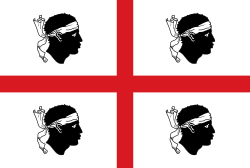 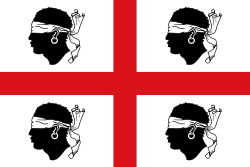 | |
| Name | The four Moors |
|---|---|
| Use | Civil and state flag |
| Proportion | 3:5 or 2:3 |
| Adopted | Used since 1281; latest version adopted in 15 April 1999 |
The flag is composed of the St George's Cross and four heads of Moors, which in the past may not have been forehead bandaged but blindfolded and turned towards the left. But already well-preserved pictures from the 16th century clearly show a forehead bandage (see gallery below). The most accepted hypothesis is that the heads represented the heads of Moorish princes defeated by the Aragonese, as for the first time they appeared in the 13th-century seals of the Crown of Aragon – although with a beard and no bandage, contrary to the Moors of the Sardinian flag, which appeared for the first time in a manuscript of the second half of the 14th century.
History
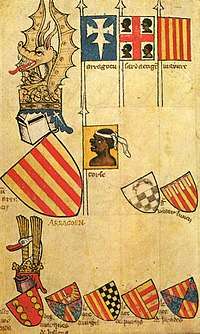

The oldest certified emblem of the four Moors dates back to 1281: it was the seal of the Royal Chancellery of Peter of Aragon, but the four heads had no bandages and were bearded; the coat of arms of Sardinia never appeared in such a way.
After the kingdom of Sardinia was founded in 1326, it became part of the Crown of Aragon; these seals will come to closing documents of King James II (1326), Alfonso Benigno (1327–1336) and Peter I (1336–1387). Some specimens are preserved in the Historical Archive of the city of Cagliari. The late 14th century Gelre Armorial attributes the Four Moors to the Kingdom of Sardinia in the states of the Crown of Aragon. It is found in another Armorial perhaps from Lorraine area (preserved in the National Library of France) and of uncertain date but certainly in the 15th century. In 1509, in another Portuguese Armorial Book (Livro do Armeiro-mor), Sardinia is represented only with the cross of St. George.
The Four Moors begin to be used consistently as a symbol of the Kingdom of Sardinia during the time of the Catholic Monarchs, and especially from the time of the Emperor Charles V. A book printed by Plantin, Antwerp, representing the funeral procession of Charles V composed of bishops and harnessed horses with the insignia of each state.
In Sardinia, the first safe attestation of the coat of arms is on the cover of the Acts of the military arm of the Sardinian Parliament, the Capitols de Cort del Stament Militar de Serdenya printed in Cagliari in 1591.
At this time, now the memories of the long and often fratricidal wars with the Judge of Arborea was ebbing away, the Iberian settlers were now included in the Sardinian society, with the passing of generations, becoming an integral part for inclusion in a political organization in which not only Sardinia but also Aragon and Catalonia were small components. It meant that the accession at the Imperial Habsburg Ideology, reinvigorate also the sense of belonging to that little State that was represented by the Four Moors. Over the centuries the flag or coat of arms of the four Moors were depicted in various ways: without bandage, with blindfold or forehead, facing to luff or to fly end, or crowned, with no Moors, in reverse, and this according to the mode of the charged artist, such as that under the leadership of Diego Velázquez and Francisco de Zurbarán represented in the Palacio del Buen Retiro in Madrid. Throughout the period of the Iberian monarchies, the original design of the bandages on his forehead is respected.
Ever since the House of Savoy ruled Sardinia in the mid-18th century, instead, the iconography of putting the blindfold over the eyes of the Moors settled and continued to persist until 1999, within the flag of St. George, in every quarter and in the direction of the luff. The Coat of Arms of the Kingdom of Sardinia clearly leads the four Moors with the bandage on their foreheads. The blindfold appears in 1800: it was either due to a mistake of a copyist or a deliberate act as a mark of protest against the Mainland rulers.
In 1952, the shield of the blindfolded eyes Four Moors became the official flag of the Autonomous Region and also adorned his banner (Decree of the President of the Republic of 5 July 1952). In 1999, a special regional law changed the flag of the Four Moors from the version adopted under Savoyard rule to the original one, as described in the introduction.[2]
Legendary origin
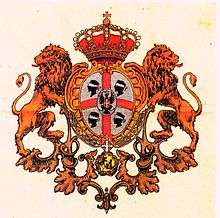
There are separate Spanish and Sardinian traditions to explain the origin of the flag and there is no consensus among scholars as to which is correct. According to the Spanish tradition, it was a creation of King Peter I of Aragon, celebrating his victory at the Battle of Alcoraz in 1096. It was said that St. George miraculously appeared on the field of battle and that there were four severed heads of Saracen kings at the end; thus the red cross and white background of the St George's Cross and the heads of four Moors.[3] The Sardinian-Pisan tradition attributes the arms to a banner given by Pope Benedict VIII to the Pisans in aid of the Sardinians in a conflict with the Saracens of Musetto who were trying to conquer the Italian peninsula and Sardinia. This flag, however, has inverted colours and no heads on it.[4]
Before the Kingdom of Sardinia was founded, the rulers of the island were known as archons (ἄρχοντες in Greek) or judges (iudices in Latin, judikes in Sardinian, giudici in Italian). The island was organized into one "judicatus" from the 9th century on (see List of monarchs of Sardinia). After the Muslim conquest of Sicily in the 9th century, the Byzantines, who previously ruled Sardinia, couldn't manage to defend their far west province. Probably, a local noble family acceded to power, still identifying themselves as vassal of the Byzantines, but independent "de facto", as communications with Constantinople were very difficult. At the beginnings of the 11th century, an attempt to conquer the island was made by Spanish Muslims. We have very little record of that war, only by Pisa and Genoa chronicles. Christians won, but after that, the previous Sardinian kingdom was totally undermined and divided into four more little judicati: Cagliari, Arborea, Gallura, and Torres or Logudoro; each one developed its own coat of arms. When, with the appointment of the King of Aragon as King of Sardinia, the island again became one united kingdom, only the Judicatus of Arborea survived, and fought for a century against the Kingdom of Sardinia for supremacy.
According to some, the flag derives from Alcoraz victory of 1096, is linked to the Crown of Aragon, and represents the Spanish Reconquista against the Moors who occupied most of the Iberian Peninsula. It is composed of the cross of St. George, also a symbol of the Crusaders fighting in the same time in the Holy Land, and the four severed heads, representing four major victories in Spain by the Aragonese: the reconquest of Zaragoza, Valencia, Murcia, and the Balearic Islands. According to others (Mario Valdes y Cocom),[5] the Moors represent the Egyptian Saint Maurice, martyred under Diocletian, and are shown in this manner, with the heads bandaged, in countless coats of arms in the Franco-German area. Even Saint Victor of Marseilles, who was from the same Theban Legion commanded by Maurice and escaped the decimation, is represented by a blackamoor with a bandage on his forehead, as in the High Altar of St. Nicholas' Church of Tallinn,[6] now in the Art Museum of Estonia, Tallinn. The common tradition which links the stories of the two saints suggests that the symbol was designed between the St. Maurice Abbey Canton of Valais (Switzerland) and the Abbey of St. Victor in Marseilles; each was built in the place of martyrdom of the respective saint. Between 1112 and 1166 the County of Provence was under the direct control of the kings of Aragon, and until 1245 ruled by descendants of the same dynasty. It should also be noted that the abbey of St. Victor of Marseilles had extensive property and political influence in Sardinia, especially in the Judicatus (kingdom) of Cagliari, from the 11th to the 13th century. There are [[hagiography|hagiographyies}} of many "Saint Victor" related to the Theban Legion, as Viktor of Xanten or Victor of Solothurn and to the persecutions of Diocletian and Maximinus II as Victor Maurus of Milan, Victor of Puigcerdà, Spain, probably inspired by the same martyr.
However, the four Moors became the symbol of the Kingdom of Sardinia at its foundation, with the Corsican flag dating back to the same era, and became in time the flag of the island and its people. In any case, the meaning of the symbols, either two holy warriors or Moor heads cut off, makes it an emblem of warring Christianity, crusader in the broad sense of the term, originated in a historical period of bitter conflict between Islam and Christianity, in which Sardinia was fully involved.
Modern use
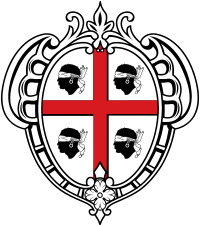
The Sardinian Action Party was founded in 1921 and adopted the four Moors as its symbol. It is conceivable that it had historically been interpreted as the icon of the four judges, as argued by Antonio Era, professor at the University of Sassari and the Regional Council, on 19 June 1950 in the discussion of the regional council before the vote that would declare the Four Moors to be the official flag of Sardinia. Era criticized the banner, stating:
Mind that the emblem of the Four Moors is not, as they say, the four judges in which Sardinia was divided nine centuries ago when it was free and independent: it is an error of historical interpretation, and therefore it is not obvious nor indispensable to choose just that emblem. That is, yes, a popular coat of arms and consecrates the centuries-old tradition of Sardinia, as mentioned in the agenda, but it is not a very Sardinian emblem as it is usually imagined.[7]
This speech denounced the fact that the flag was not of Sardinian origin, but it is also documentary evidence of popular feeling that he read it in the medieval Giudicati history. On the other side, the history of the Giudicati developed mainly after the victory of the maritime republics against the Saracens, which allowed the development of the four little kingdoms and the coincidence was perfectly expressed by the four Moors.
Out of the many separatist parties active on the island, a minor Sardist party (IRS) does not recognize the flag as being historically representative of Sardinia and its people, due to its origin dating back to Aragonese rule. Such party prefers to use the eradicated tree flag, the coat of arms of the judge of Arborea, considered the last autochthonous Sardinian state, as the party's flag. However, the eradicated tree is also the Aragonese emblem of Sobrarbe and, despite no in-depth studies, could also originate as part of the Aragonese conquest.
Chronological gallery
Crown of Aragon
The four moors already represent the Kingdom of Sardinia but no trace is found in the island.
 Gelre Armorial, Folio 62r
Gelre Armorial, Folio 62r Armorial from Lorraine region (France), 1450
Armorial from Lorraine region (France), 1450
Imperial ideology of Charles V, Habsburg House, A little kingdom within an enormous empire
The four moors appear more frequently in prints, paintings, artifacts both in Sardinia and in all publications heraldic vintage.
 1509, Portuguese armorial "Livro do armeiro-mor", Lisbon
1509, Portuguese armorial "Livro do armeiro-mor", Lisbon 1515 from the emperor Maximilian I Triumphal Arch by Albrecht Durer
1515 from the emperor Maximilian I Triumphal Arch by Albrecht Durer Emperor Charles V and his Kingdoms' coats of arms
Emperor Charles V and his Kingdoms' coats of arms Imperial eagle of Charles V
Imperial eagle of Charles V.jpg) 1555 - Innsbruck, the peacock of the Habsburg dynasty
1555 - Innsbruck, the peacock of the Habsburg dynasty 1555 Virgil Solis
1555 Virgil Solis 1559 H. Cock-J. Doetichum-L. Doetichum, “La magnifique et somptueuse pompe funebre faite aus obseques et funerailles du tres grande et tres victorieus empereur Charles cinquieme”, Plantin, Anvers, The funeral cortège of Charles V in a printed book.
1559 H. Cock-J. Doetichum-L. Doetichum, “La magnifique et somptueuse pompe funebre faite aus obseques et funerailles du tres grande et tres victorieus empereur Charles cinquieme”, Plantin, Anvers, The funeral cortège of Charles V in a printed book.- detail
 The Genealogical Tree of the House of Habsburg, Robert Peril, 1540
The Genealogical Tree of the House of Habsburg, Robert Peril, 1540
Habsburg House (Spanish branch)
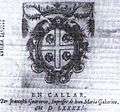 1590 F. Guarnerio, Capitols de cort del Stament Militar de Sardenya, Cagliari, first recorded use in Sardinia.
1590 F. Guarnerio, Capitols de cort del Stament Militar de Sardenya, Cagliari, first recorded use in Sardinia. 16th century, Sassari (Sardinia), Palazzo Ducale, coat of arms of Philip II of Spain
16th century, Sassari (Sardinia), Palazzo Ducale, coat of arms of Philip II of Spain 1573 I. Mainoldi Galerati, De titulis Philippi Austrii Regis Cattolici Liber, Bononia
1573 I. Mainoldi Galerati, De titulis Philippi Austrii Regis Cattolici Liber, Bononia H. De Bara, Le Blason des Armoires, Lyon
H. De Bara, Le Blason des Armoires, Lyon 1585, portrait of Philipo II of Spain by Agostino Carracci
1585, portrait of Philipo II of Spain by Agostino Carracci.jpg) 1607, coat of arms of the University of Cagliari
1607, coat of arms of the University of Cagliari Frans Franken II (1581-1642), Abdication of the emperor Charles V, Rijksmuseum, Amsterdam
Frans Franken II (1581-1642), Abdication of the emperor Charles V, Rijksmuseum, Amsterdam detail
detail 1640 from a geographic map
1640 from a geographic map 1700, Descripciones de todos los reyes de España, Josè Delitala y Castelvì, conde de Villasalto
1700, Descripciones de todos los reyes de España, Josè Delitala y Castelvì, conde de Villasalto Portada de los Anales de la Corona de Aragón. The four moors became the coat of arms of Aragon as well, crowned and bearded.
Portada de los Anales de la Corona de Aragón. The four moors became the coat of arms of Aragon as well, crowned and bearded.- Apoteosis Heraldica 1681 Museo de Historia de la Ciudad,Barcelona; the iconography of the 4 Sardinian Moors are clearly from the 4 Moors of Aragon, crowned and bearded.
Out of the island the artists run wild
 16th century, "Libro de armas y blasones de diversos linajes y retratos", with inverted colours.
16th century, "Libro de armas y blasones de diversos linajes y retratos", with inverted colours.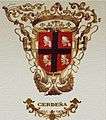 1635, Zurbaran and Velasquez, Buen Retiro Palace, Madrid, again inverted colours
1635, Zurbaran and Velasquez, Buen Retiro Palace, Madrid, again inverted colours "El Triunfo del Emperador Maximiliano I", 17th century ?, the four moors became three in a printed book from Austrian area.
"El Triunfo del Emperador Maximiliano I", 17th century ?, the four moors became three in a printed book from Austrian area.
Savoy House
As the title of King of Sardinia was the only one who gave the ruling dynasty the coveted title, the coat of arms is enhanced and developed and overlaid with emblems of the other states ruled by the Savoy House
 1773, I. G. Palietti, Pharmacopoea sardoa, Tipografia Regia, Cagliari
1773, I. G. Palietti, Pharmacopoea sardoa, Tipografia Regia, Cagliari.svg.png) Civil Flag and Civil Ensign of the Kingdom of Sardinia (1816-1848)
Civil Flag and Civil Ensign of the Kingdom of Sardinia (1816-1848) Variant flag used as naval ensign in the late 18th or early 19th century[8]
Variant flag used as naval ensign in the late 18th or early 19th century[8]
Contemporary use
See also
- Flag of Corsica
- Maure
References
- http://www.regione.sardegna.it/j/v/86?v=9&c=72&s=1&file=1999010
- Sì ai quattro mori sbendati, Il governo approva la nuova bandiera sarda, La Nuova Sardegna
- Jerónimo Zurita (1668). Anales de la Corona de Aragon. Dormer. p.32 paragraph XCVI. Retrieved 28 March 2013.
- Ranieri Sardo, Cronaca di Pisa, (Manuscript Magliabecchi XXV-491, 1440-1450) a cura di Ottavio Banti, Istituto Italiano per il medioevo, 1963
- https://www.pbs.org/wgbh/pages/frontline/shows/secret/famous/ssecretum1.html
- Estonia, oil on wood, St. George, St. Nicholas and St. Victor of Marseilles, 1481 by Rode, Hermen (c.1468-1504)
- Antonio Era, Address to the Regional Council, 1950
- Italian states to 1861 - History of the flag and chronology
Sources
- Giovanni Battista Fara, De Rebus Sardois, Cagliari, 1580
- Geronimo Zurita, Anales de la Corona de Aragon, Zaragoza, 1610
- Ferran De Sagarra, Sigillografia Catalana, inventari, descripciò i estudi dels segells de Catalunya, Barcelona, 1915
- Martì De Riquer, Heràldica catalana des de l'Any 1150 al 1550, Barcelona, 1983
- Salvatorangelo Palmerio Spanu, Origine dell'Arme di Sardegna, ESHA
- Barbara Fois, Lo stemma dei quattro mori: breve storia dell'emblema dei sardi, Sassari, Carlo Delfino Editore, 1990
- Franciscu Sedda, La vera storia della bandiera dei sardi, Cagliari, Edizioni Condaghes, 2007
- Mauro Podda, Quattro mori a Bruxelles, L'Unione Sarda, 12 aprile 2008, Cagliari